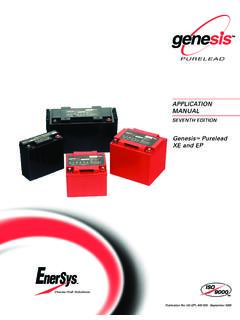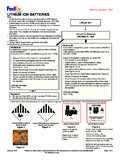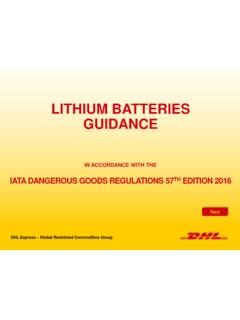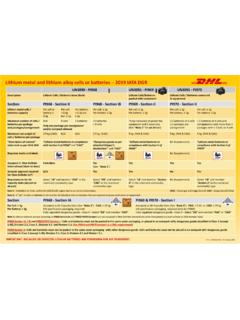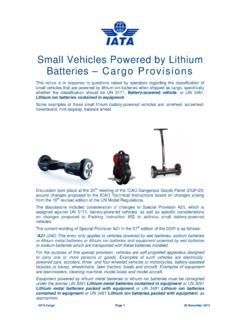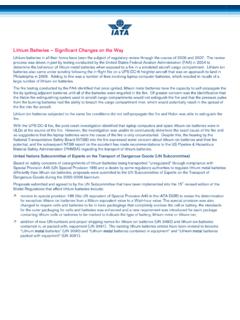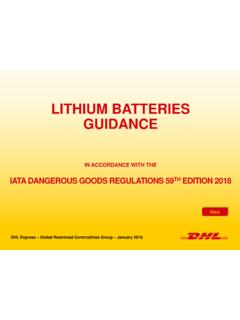Transcription of Transportation Regulations for Lithium and Lithium Ion ...
1 New Lithium battery Regulations issued by DOT on August 9, 2007. Transportation Regulations for Lithium , Lithium Ion and Polymer Cells and batteries Which organizations and Regulations govern the transport of Lithium , Lithium ion and polymer cells and batteries ? The Regulations that govern the transport of primary (non-rechargeable) Lithium ( metal ) and rechargeable Lithium ion (including polymer) cells and batteries include the International Civil Aviation Organization (ICAO) Technical Instructions and corresponding International Air Transport Association (IATA) Dangerous Goods Regulations , and the International Maritime Dangerous Goods (IMDG) Code. In addition, Lithium and Lithium ion cells and batteries are regulated in the in accordance with Part 49 of the Code of Federal Regulations , (49 CFR Sections 100-185) of the Hazardous Materials Regulations (HMR).
2 Section and the Special Provisions contained in Section provide information on the exceptions and packaging for shipping based on details of weights, tests and classifications. The hazardous materials table in Section also provides related shipping information. The Office of Hazardous Materials Safety, which is within the Department of Transportation s (DOT) Pipeline and Hazardous Materials Safety Administration (PHMSA), is responsible for writing the Regulations that govern the Transportation of hazardous materials (also known as dangerous goods) by air, rail, highway and water and drafting the Regulations that govern such materials. These Regulations are based on the UN Recommendations on the Transport of Dangerous Goods Model Regulations and UN Manual of Tests and Criteria.
3 What Transportation Regulations are currently in effect in the Based on the mass of Lithium in the anode of a Lithium metal or Lithium alloy cell (for primary cells and batteries ) and equivalent Lithium content (for Lithium ion cells and batteries ), the shipping Regulations outlined in the chart below are currently in effect or go into effect on January 1, 2008. However, the DOT published a Lithium battery final rule on August 9, 2007 that provides shippers additional time to comply with certain marking and testing requirements when shipping small cells and batteries . See footnotes below. Pages 2 and 3 contain additional requirements on shipping primary Lithium ( metal ) cells and batteries . Primary Cell / Battery Max. Lithium Content Lithium Ion & Polymer Cell / Battery Max.
4 Lithium Content Shipping Classification/Testing Special gram / grams grams / grams Excepted / T1-T8(1) Yes(2) grams / 25 grams grams / 25 grams Class 9 / T1-T8(3)(7) Yes(5) > grams / >25 grams > grams / >25 grams Class 9 / T1-T8(4)(7) Yes(6) (1) Starting October 1, 2009, cells and batteries must pass UN T1-T8 Tests. Cells and batteries that pass UN Tests are excepted from regulation. (2) Starting October 1, 2008, packages containing more than 12 batteries or 24 cells must meet certain packaging, marking, and shipping paper requirements. See pages 7 and 8. (3) Cells and batteries must pass UN T1-T8 Tests. Starting October 1, 2008 must be shipped as Class 9 hazardous materials unless transported by motor vehicle or rail car.
5 (4) Must pass UN T1-T8 Tests and be shipped as a Class 9 hazardous material. (5) Requires Class 9 markings, label, specification packaging, and shipping papers unless transported by motor vehicle or rail car. See page 3 and Exhibit A. (6) Requires Class 9 markings, label, specification packaging, and shipping papers. See Exhibit A. (7) 49 CFR (a)(1) allows for a cell or battery that was first transported prior to January 1, 2006 and is of a type tested pursuant to the UN Manual of Tests and Criteria, Third Revised Edition, 1999, need not be retested. Oct 22 2007 Rev. T Copyright 2003-2007 Ultralife batteries , Inc. All Rights Reserved UBM-5120 Page 1 of 11 Transportation Regulations for Lithium , Lithium Ion and Lithium Polymer Cells and batteries Oct 22 2007 Rev.
6 T Copyright 2003-2007 Ultralife batteries , Inc. All Rights Reserved UBM-5120 Page 2 of 11 How is equivalent Lithium content calculated for Lithium ion cells and batteries ? Equivalent Lithium content for Lithium ion and Lithium polymer cells and batteries in grams on a per cell basis is calculated as times the rated capacity in ampere-hours. The equivalent Lithium content for a battery or battery pack is the rated capacity in ampere-hours for a single cell multiplied by and then multiplied by the number of cells in the battery. What international Transportation Regulations currently are in effect? The international Transportation Regulations require battery and cell manufacturers or companies that ship equipment packed with or containing these cells and batteries to meet UN testing, marking, packaging, labeling and shipping paper specifications.
7 These Regulations are incorporated into the ICAO Technical Instructions, IATA Dangerous Goods Regulations , and IMDG Code. Based on Lithium content (for primary cells and batteries ) and equivalent Lithium content (for Lithium ion cells and batteries ), the following international shipping Regulations apply: Primary Cell / Battery Max. Lithium Content Lithium Ion & Polymer Cell / Battery Max. Equiv. Lithium Content Shipping Classification/Testing Special Packaging/Markings gram / grams grams / grams Excepted / T1-T8 (1 ) Yes (2) > gram / > grams > grams / > grams Class 9 / T1-T8 (3) Yes (4) (1) Cells and batteries must pass UN T1-T8 Tests. Cells and batteries that pass UN Tests are excepted from regulation.
8 NOTE: The IMDG Code contains a grandfather clause for testing small cells and batteries until December 31, 2013. (2) Packages containing more than 12 batteries or 24 cells must meet certain packaging, marking, and shipping paper requirements. See pages 7 and 8. (3) Cells and batteries must pass UN T1-T8 Tests and be shipped as Class 9 hazardous materials. (4) Requires Class 9 markings, label, specification packaging, and shipping papers. See Exhibit A. The DOT prohibits the transport of primary Lithium ( metal ) cells and batteries as cargo by passenger aircraft into, out of, or within the United States. What are the implications on shipments of primary Lithium ( metal ) cells and batteries ? The DOT prohibits the offering for Transportation and Transportation of primary Lithium ( metal ) cells and batteries as cargo aboard passenger-carrying aircraft into, out of, or within the United States.
9 However, primary Lithium ( metal ) cells with no more than 1 g of Lithium content and batteries with an aggregate Lithium content of no more than 2 g THAT ARE PACKED WITH OR INSTALLED IN EQUIPMENT are not subject to this prohibition provided the net weight of the batteries in each package does not exceed 5 kg and the package contains no more than the number of Lithium batteries or cells necessary to power the piece of equipment. The following statement (marking) must be placed on packages containing only primary Lithium ( metal ) cells with no more than 1 g of Lithium content and batteries with an aggregate Lithium content of no more than 2 g that are excepted from regulation under the HMR: PRIMARY Lithium batteries FORBIDDEN FOR TRANSPORT ABOARD PASSENGER AIRCRAFT or Lithium metal batteries - FORBIDDEN FOR TRANSPORT ABOARD PASSENGER AIRCRAFT.
10 The marking must be on a background of contrasting color in letters at 12 mm ( inch) in height on packages having a gross mass of more than 30 kg (66 pounds); or at least 6 mm ( inch) on packages having a gross mass of 30 kg (66 pounds) or less. Packages containing primary Lithium ( metal ) cells with more than 1 g of Lithium content and batteries with an aggregate Lithium content of more than 2 g and shipped by cargo aircraft must contain the Cargo Aircraft Only label. Transportation Regulations for Lithium , Lithium Ion and Lithium Polymer Cells and batteries Oct 22 2007 Rev. T Copyright 2003-2007 Ultralife batteries , Inc. All Rights Reserved UBM-5120 Page 3 of 11 Recommended marking for use on packages containing primary Lithium ( metal ) cells with no more than 1 g of Lithium content and batteries with an aggregate Lithium content of no more than 2 g that are excepted from regulation under the HMR: Lithium metal batteries FORBIDDEN FOR TRANSPORT ABOARD PASSENGER AIRCRAFT The DOT s Lithium battery final rule that was published on August 9, 2007 also includes a new Special Provision 189 that provides an exception for medium size primary Lithium ( metal ) cells and batteries and rechargeable Lithium ion cells and batteries transported by motor vehicle or rail car.





